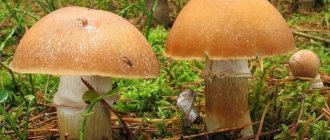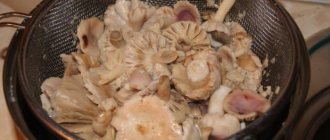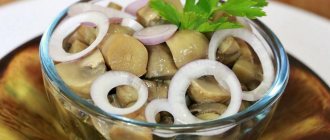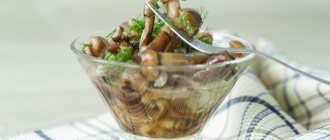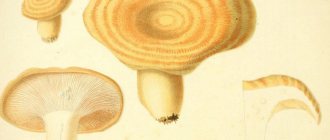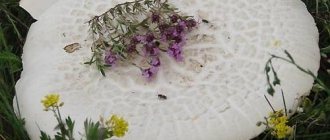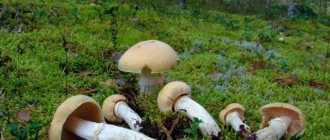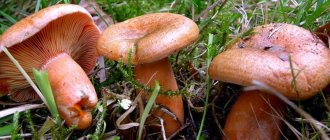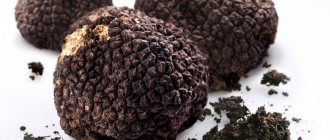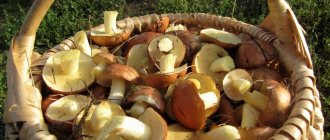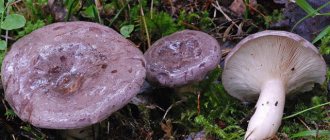Chicken mushrooms are so named not because of their external resemblance to this bird, but because they have a similar taste when cooked in certain ways. Despite not the most beautiful appearance, they have excellent taste. You can use them to prepare mushroom hodgepodge and soups. To prepare for the winter, methods of drying, pickling, salting, and stewing are used. Before cooking, the chickens must be collected. The difficulty is that they look like an inedible member of the spider web family.
Chicken mushrooms are named so not because of their external resemblance to this bird, but because they have a similar taste
Description of mushrooms
The row is gray or streaked - under these names in the dictionaries there is a description of the chickens.
In the dialects of different regions there are other names:
- Greenfinches;
- Gray Sandpiper;
- Podzelenki;
- Cockerels.
Some of its varieties, indeed, over time acquire a resemblance to a cockscomb. These include gray sandpipers; in old mushrooms, the cap rises in a wave and resembles a cockscomb; it does not have a round shape. It is found mainly in sandy soils of pine forests.
In mixed forests, other subspecies predominate. Their caps are round and resemble an umbrella. The peculiarity of the cap is that its edges diverge as it grows, and the lamellar part protrudes outward. You can distinguish them from cobwebs by the “skirt” on the leg. Spider webs do not have it, and even in cockerels it disappears over time. As the leg grows, the skirt becomes tight, it breaks, forming a kind of ring on the leg.
Attention! It is better to collect chickens for the first time under the supervision of a mushroom picker who knows them.
Edibility, beneficial properties and contraindications for use
You may be interested in: How do edible talkers differ from false mushrooms? How many days after rain do mushrooms grow? Bitter mushroom: photo and detailed description
Chickens are not only edible, but also incredibly tasty. Their aromatic pulp, reminiscent of chicken meat, will help diversify the menu, with the possible exception of desserts. Prepared from chickens:
- soups;
- gravy;
- sauces;
- roast;
- fried foods;
- pizza and sandwiches.
In terms of nutritional value, cockerels are not inferior to champignons and boletus mushrooms. Low calorie content (22 kcal) is combined with a rich chemical composition. Chickens contain a lot of ascorbic acid, macroelements (calcium, magnesium, zinc, iron) and amino acids.
100 g of product contains:
- 3.1 g protein;
- 0.34 g fat;
- 3.26 g carbohydrates;
- of which 1 g is fiber.
Good to know!
This mushroom also has medicinal benefits. An antiviral protein drug RC-28 was created from its mycelium. It successfully fights herpes, influenza and cytomegaloviruses.
Like other mushrooms, cockerels cannot be collected in environmentally polluted areas, as they absorb toxins and heavy metals from the atmosphere and water. Unfortunately, not everyone can include these fruits in their diet. Chickens are contraindicated:
- pregnant and lactating women;
- those suffering from gastrointestinal diseases;
- for preschool children.
Salting for the winter
The main disputes between housewives are about the method of preparing forest gifts for the final stage of cooking. Some insist that it is necessary to boil them in three waters, while other housewives cook without skipping the cooking process altogether.
The main indication for boiling cockerels is the contaminated area where they were collected.
The main disputes between housewives are about the method of preparing forest gifts for the final stage of preparation.
Like any mushrooms, greenfinches accumulate in their bodies all types of contaminants that are found in the soil and air. It is generally not recommended to collect mushrooms near roads and factories, but there are practically no such places left in the European part of the country. In this regard, the question arises of how long to cook them.
Cooking time
The closer to the roads the mushrooms grow, the longer they need to be cooked. This lies not so much in the time of heat treatment, but in the number of times the water is replaced.
Mushrooms collected in mixed forests need to be boiled 3 times for 5 minutes.
Sand can get stuck between the plates, so that it does not creak on the teeth in the finished dish, the water needs to be changed 5 or even 7 times.
The closer to the roads the mushrooms grow, the longer they need to be cooked.
Mushrooms collected away from roads and industrial facilities can be skipped and immediately started frying or stewing a dish that contains these mushrooms.
Royal salting
Sand is better removed from mushrooms in cold water under pressure. With this method of preparing mushrooms for pickling, harmful substances are also removed from them. But you can try the first mushrooms no earlier than in 40 days. It’s better to cook them in an oak barrel.
Ingredients:
- Mushrooms – 10 kg;
- Salt – 1 kg;
- Sweet peas – 30 g;
- Cloves – 20 g;
- Several stems of dill with umbels of seeds.
Sand is better removed from mushrooms in cold water under pressure
Method of preparation;
- Steam the barrel with juniper to destroy all microorganisms.
- Place the washed mushrooms in a barrel, salting each layer with a portion of salt. A third of all the salt should be left for re-salting.
- Fill the contents of the barrel with cold water;
- Cover the top with two wooden semicircles.
- Place a heavy stone on top, calcined in fire and steamed with juniper.
- Throughout the week, it is necessary to remove the foam that has formed on top.
- After a week, the water is completely drained. It is replaced with a new one. When re-watering the mushrooms, you need to add sweet peas, cloves and dill.
- The barrel must be rinsed before refilling. Dill is placed at the bottom.
- The mushrooms are also added in layers, only this time there will be three times less salt.
- The barrel is covered with a wooden lid, consisting of two parts, on top of which oppression is also laid.
- The workpiece must be moved to a cool cellar or pantry.
After a month and a half, you can eat mushrooms. They will be crispy and not very salty. If the first water is not drained, then the workpiece will contain bitterness.
Fast way
Not only mushrooms pickled in cold water can be crispy and dense. The method of hot salting with an oak leaf is effective, but faster. In addition, you don’t have to think about where to put the blanks.
For cooking, it is better to take 0.5-1 liter jars and metal lids for sealing.
Products you will need:
- 3 liters of water;
- 150 gr. salt;
- 4-5 pcs. sweet pea;
- 2-3 pcs. carnations;
- 8-10 black peppercorns;
- 1 bay leaf for each jar;
- 3-4 cloves of garlic (in each jar):
- 2-3 onion rings.
Not only mushrooms pickled in cold water can be crispy and dense.
Method of preparation:
- Cleanly washed and free of dirt mushrooms must be filled with water and boiled for 5 minutes.
- Drain the water, add fresh water, and repeat the procedure.
- During the last boiling of the mushrooms, 3 liters of boiling water must be placed on the adjacent burner.
- Salt, peppers and cloves are added to boiling water. You can immediately move the mushrooms that have been squeezed out of excess water with them.
- The chickens also need to be boiled in salted brine for 5 minutes so that they are salted.
- Peeled garlic cloves, onion rings or half rings, and bay leaves are placed in clean jars.
- Immediately after turning off the gas, the mushrooms are placed in jars along with the brine.
- The jars are rolled up with lids. They should cool at room temperature, after which they should be put in the refrigerator.
Advice! It is better not to boil the bay leaf, otherwise the brine will be bitter and not aromatic.
Characteristic features of the variety
Despite their geographical widespread distribution, ringed caps are undeservedly ignored. This happens due to the caution of mushroom pickers who confuse edible rosetes with its poisonous counterparts.
Chicken mushrooms really resemble the pale toadstool with its skirt, which is shown in the photo, but after studying the description and differences, you can easily recognize the edible forest delicacy.
Appearance and structure
Appearance changes as it grows. At the beginning of its development, the cap has the shape of a hemisphere with slightly curled edges, which are attached to the stem. The diameter of the cap is up to 4 cm. As it grows, the edges diverge and tear the cover, leaving a ring with a skirt on the leg to prevent tearing. The cap grows up to 10 cm in diameter and takes the shape of a wide cap with a bulge in the center.
The color of the cap is brownish-pink. In dry weather, the edges of the cap dry out and crack slightly. On the inside there are white-yellow plates of the spore apparatus, which acquire a rusty tint during the maturation of the spore powder. The outer side of the cap is dissected with thin creases, covered with a light coating. At the edge, the pollen forms scales that look like those of a fly agaric, which confuses inexperienced mushroom pickers.
You may be interested in:
How to distinguish whether a Polish mushroom is edible or not: useful tips (22 photos) An interesting and most striking representative of the genus of fly mushrooms is the Polish mushroom. It belongs to the second category...Read more...
The pale yellow leg is cylindrical in shape. The structure up to the ring is more silky and bright, above the ring it is scaly and pale. The pulp is dense with a pleasant mushroom smell. The color does not change when cut.
Place of distribution
The species is distributed in Europe, Asia, Japan, and the USA. In Belarus, chickens can be found everywhere. They grow throughout the area and are popular.
Mushroom growth areas
The favorite soil is damp and acidic, on which mixed and coniferous forests, as well as lingonberry and blueberry bushes, are well distributed. You can meet chickens both in the mountains and on the outskirts of swamps, which is why they received another name - marshlanders.
Taste and collection rules
An edible, tasty mushroom, the flesh of which resembles boiled chicken breast, and is consumed fried, stewed, pickled and salted. You should go hunting from July to October-November. If you come across a mycelium of chickens, then, without leaving your spot, you can collect a bucket, because they grow in vast plantations in a circle.
Collection of chickens
Since the marsh grass can be confused with its poisonous twins, when going for this species for the first time, you should take with you someone who understands them, or a picture of the edible and dangerous species. It is also necessary to use the main rule of mushroom pickers: if you’re not sure, don’t take it.
You should not take old, wormy or rotten mushrooms. If these have already ended up in your basket, then you shouldn’t throw them away or trample them, just prick the fruiting body onto a branch, and then, when ripe, it will shed spores and increase the yield.
How to distinguish from false, inedible
The ringed cap has two terrible doubles with which an inexperienced mushroom picker can confuse it - the fly agaric and the toadstool. You can distinguish it from a fly agaric by the following characteristics:
- the scales on the fly agaric cap extend over the entire area, but on the cap only along the edge;
- The smell of the pulp of an inedible mushroom is unpleasant, while that of an edible one is mushroom-like;
- the plates of the fly agaric are free, those of the cap are adherent to the stem;
- the fly agaric has a vulva at the base, the chicken does not.
When comparing with a pale grebe, pay attention to the following signs:
- Edible mushrooms do not have a sac-like formation at the base of the stem;
- The toadstool has fused plates, but the cap does not.
Pale toadstool often grows among caps, therefore, having discovered a rich clearing, it is necessary to inspect each fruiting body that is placed in the basket.
Pickled greenfinches
It is necessary to marinate mushrooms so that neither salt nor vinegar interrupts their taste, but rather emphasizes it.
Ingredients of the marinade:
- 1 liter of water;
- 1 dessert spoon of salt;
- 1 dessert spoon of granulated sugar;
- 2 dessert spoons of table vinegar 4.5%;
- Half a glass of vegetable oil;
- Sweet peas – 2 pcs;
- Zira – 8-12 grains;
- Rosemary – 8-12 grains.
Attention! Zira and rosemary give a delicate aroma. If necessary, they can be replaced with caraway seeds or dill. The dish will acquire a different flavor, it will be brighter, but no less original.
Cooking method:
- Washed mushrooms are boiled in two waters. The liquid is drained after boiling mushrooms in it for 5 minutes.
- The marinade is prepared in a smaller saucepan, but the last stage of cooking the mushrooms requires that the boiled mushrooms be placed in it along with the marinade.
- After the water boils, spices are added to make the brine moderately spicy. Vinegar is added last.
- The chickens are placed in a colander, washed with additional running water and placed in a pan with marinade.
- After the marinade with mushrooms boils, the gas is turned off.
- The hot product is placed in jars and covered with lids.
- Once cooled at room temperature, the jars are stored in a refrigerator or a concrete pit in the garage.
Attention! If mold has formed inside a jar of mushrooms during storage, it is better to throw it away to avoid poisoning.
Preparatory stage
Chicken breast is not cooked before drying. Therefore, the choice of meat must be approached with maximum responsibility.
When buying a fillet or a whole chicken at the market or in a supermarket, the first thing you need to do is make sure the product is fresh. Poultry meat should be light, pale pink, without bruises or foreign inclusions. The smell is pleasant, slightly sweet. It is advisable to buy steamed (chilled) chicken. Frozen meat loses its juices and, although quite a bit, is worse in taste than fresh meat.
Before salting, the chicken breast is filleted - the skin is removed and the keel bone is cut out. For ease of processing, fillet is divided in half.
A mandatory step for any recipe for dried chicken breast is stripping the meat of films, fat, and tendons. After the fillets are washed and blotted from excess moisture with paper towels.
Spices for marinating chicken meat before drying are chosen at your discretion. You can limit yourself to just salt and ground red and black pepper. Or marinate the breast in a mixture of seasonings. Oregano, marjoram, basil, cumin, paprika, turmeric, suneli hops, and garlic go well with dietary meats.
Alcohol, which is often added to homemade dry-cured sausages and meat, acts solely as a preservative. It does not add any taste or smell to the finished product, but it significantly extends its shelf life.
Breaded mushroom recipe
To prepare you need to prepare:
- Flour;
- Salt;
- Egg;
- Breadcrumbs.
Cooking method:
- Caps of cleaned and washed mushrooms should be dipped in a batter made from flour, salt and eggs. The final layer will be breading.
- Vegetable oil is poured into a hot frying pan, ensuring that the battered cockerels are immersed in it at least halfway.
- The fire under the boiling oil is reduced, and mushroom preparations are immersed in it.
- The browned roosters are turned over and browned on the other side.
- If you have the feeling that they are not cooked enough, they can be sent for additional heat treatment in an oven preheated to 180° C for half an hour.
The dish can be served hot or cold. An excellent sauce for it would be sour cream, without any additions.
Growing
To grow a chicken coop in your dacha, it is best to use spore propagation. To do this you will need:
- In the selected area for planting, remove a 25 cm thick layer of soil.
- Collect about 20–30 mushrooms and pick off their caps.
- Cut the tops into small pieces and soak in rainwater (if this is not available, you can use water from a well, which is left to settle for two days).
- After a day, the mushrooms are kneaded with hands or a wooden mortar until a homogeneous paste is obtained.
- Strain the suspension through a sieve.
- Pour the resulting solution evenly over the prepared area of land.
- Scatter mushroom paste on top.
- Cover the “planting” with soil and water.
Did you know? In 1960, mushrooms were assigned to a separate kingdom of the same name, since during lengthy debates scientists were unable to classify them as either plants or animals.
How to cook chicken?
If you try to ask people in different regions what kurnik is, you will most likely be surprised. In the south, a chicken coop is called a chicken coop. In the central regions and north of the country, kurnik is a pie. How is this dish so different from other pies that it got its own name? Firstly, such a pie was considered ritual and served at a wedding, symbolizing the rich life of the newlyweds. Secondly, the kurnik had a special - dome-shaped - shape, in contrast to flat, high, puff, pie and open pies. Thirdly, the kurnik was necessarily richly decorated with ornaments made from pieces of dough. Finally, the kurnik had several layers of filling: boiled cereals, meat, mushrooms or vegetables - between which specially baked pancakes were placed. Today, the pie can have any filling: chicken, duck, geese, pigeons, hazel grouse and partridges, beef and lamb, mushrooms and much more can be used to prepare chicken. Want to know how to cook chicken?
Stage one. Pancakes
Cooking even the simplest chicken is a difficult process, requiring a lot of skill and time. First you need to bake pancakes. They can be made with milk or water. Mix 1 egg, teaspoon of sugar, pinch of salt. Beat well, pour in about half a liter of milk or water (you can use half and half), gradually add sifted flour to make pancake dough (about one and a half glasses). Add 4 tbsp. spoons of vegetable oil, mix well and fry the pancakes in a heated frying pan, greased with a piece of lard. They should be quite dense; lace pancakes are not suitable.
Stage two. Dough and filling
While the pancakes are cooling, knead the dough. Kurnik from yeast dough is easier to prepare. To do this, pour 30 g of dry yeast with a glass of warm water, add tbsp. spoon of sugar, stir well. After 10 minutes, pour in this mixture with 300 g of sifted flour, knead the dough. Let him come. Meanwhile, prepare the filling. If you want to get a really tasty chicken, use 4-5 layers: potatoes, meat, mushrooms, onions, egg. You can prepare chicken with meat, combining, for example, chicken, veal and lamb, or poultry and game. You can also prepare a Lenten version – kurnik with potatoes and mushrooms. For the filling, peel the potatoes and cut into thin slices, cut the meat into thin long slices or pass through a meat grinder with a large attachment. You can put onions raw (finely chopped) and lightly sautéed in oil. Mushrooms can be used both raw - they need to be stewed a little and cooled - or salted.
Stage three. Assembly
So, everything is ready, but it is not yet clear how to make a chicken pot from all this. To begin, divide the dough into 2 unequal parts: roll the smaller one into a cake with a diameter slightly larger than the shape in which you will bake the pie. Place the first filling on the dough, for example, finely chopped chicken. Cover with a pancake. Place the second filling - finely chopped boiled eggs with herbs. Cover with the second pancake. The next layer is onions stewed in butter, another pancake, then mushrooms. Roll out most of the dough into a circle, make small cuts on the sides (it will look like a sun or a flower). Cover the pie and seal the edges. The kurnik is baked over low heat for quite a long time - about an hour.
Holiday option
Kurnik can be a real decoration for a holiday table if the dough is prepared with butter and milk. You can cook chicken with kefir or whey. The pancakes are fried in the same way as in the previous recipe, but the dough is prepared differently. Melt a stick of butter, add a pinch of salt and soda dissolved in lemon juice. Pour in one and a half glasses of full-fat kefir, add enough flour to make a smooth dough. It is better to use low-fat filling for such a pie.
The recipe for kurnik made from puff pastry differs little from the previous ones - just use puff pastry instead of yeast dough or kefir dough. The pie will turn out crispy and crumbly, but remember that the puff pastry must be rolled out carefully, and it does not stretch as well, so take it with a reserve.
womanadvice.ru
Varieties of saffron milk caps
The most common are three types of saffron milk caps - red, real and spruce. They differ slightly in appearance and grow in different forest areas. The main features of each type are:
Among the varieties of saffron milk caps, this mushroom is relatively small in size. The height of its stem usually reaches only seven centimeters, and the diameter of the cap is no more than nine centimeters. Such mushrooms appear among the spruce trees in August and grow until the beginning of October. The spruce saffron milk cap is distinguished by its color. The light orange cap has greenish tints, which is why it is sometimes called green saffron milk cap.
The mushroom is bright pink or deep orange in color with a strong stem slightly widened at the top, a height that can stretch up to nine centimeters in height. Red saffron milk caps grow in forests among deciduous trees. Mushroom pickers begin collecting them in the middle of summer and finish in the middle of the first month of autumn. The stem of this type of camelina often has small powdery coatings or small indentations.
It is not difficult to see such an adult mushroom in the forest thanks to its wide cap, up to fifteen centimeters in diameter, and a high stem - ten centimeters. The surface of the true camelina can be various shades of orange and red. A shiny hat with rims characteristic of saffron milk caps, and sometimes with a white coating. These mushrooms grow in moss among pine trees from June to the end of September.
Also false saffron milk caps are amber milkweeds that are not suitable for fresh consumption. The color of the cap of this mushroom is reddish-red. The juice from the pulp flows amber in color. This watery milk dries out in the air. This false camelina smells like chicory. Sometimes it is dried and used as a seasoning.
Volnushka pink
Inexperienced mushroom pickers sometimes confuse saffron milk caps with pink mushrooms. It qualifies as a conditionally edible mushroom that has no beneficial nutritional values. It is easily distinguished by the colorless liquid released when pressed and the pubescent cap.
Places of distribution
Chicken mushrooms, a photo of which shows that they are very reminiscent of some types of voles, for example, early or hard, form mycorrhiza mainly with coniferous trees, although they are found no less often under oaks or birches. In the central zone of our country, they can be collected in mossy areas in pine or mixed forests.
In mountain ranges they are found even at an altitude of two thousand meters. Chicken mushrooms are most common in Western Europe and Belarus. In our country, they are more often found in damp forest areas of Central Russia on ash and podzolic soil types. These mushrooms love to inhabit mixed forests, but are often found in pure coniferous forests, if, of course, there is enough moisture there and all the necessary conditions for reproduction and growth are present.
Of course, this representative of Rosites can hardly be considered one of the most common and popular. Experts believe that its slight external resemblance to a toadstool played a significant role in the reason for its unpopularity. However, those who once tried these mushrooms will certainly return to preparing dishes from the annular cap.
Chickens begin searching for mushrooms in mid-August. The season can last until the end of October. This mushroom especially loves thickets of blueberries and lingonberries. After the end of the berry picking, it almost completely fills the places where they are distributed in large groups. And one more interesting fact: chickens grow only in environmentally friendly areas.
( 2 ratings, average 4.5 out of 5 )
Mushroom sauce with pickles
Umbrella mushrooms make a great sauce for pasta and mashed potatoes. The washed caps for this recipe should be thinly sliced and stewed a little with bacon (50 g), seasonings and salt (to taste). Do not use vegetable oil! After 6-7 minutes, add one chopped large sweet pepper without core and seeds to the pan.
After the liquid has evaporated, pour in a mixture of a small amount of broth or water, 15% cream (125 ml) and ketchup (50 ml). The umbrella mushroom sauce should be simmered with stirring for 10 minutes. Before serving, add a couple of chopped (very finely!) pickled cucumbers to the dish.
www.kakprosto.ru
Appearance
The cap is up to 12 cm in diameter, initially ovoid in shape, with edges curled down. Subsequently, the cap takes the shape of a cap, and its edge is leveled. The color of the cap is brownish, and its surface is covered with small cracks and a whitish coating.
The hymenophore is lamellar; the plates initially have a light yellow color, and with age they become rusty-brown. In the youngest fruiting bodies they are covered with a film shell. Spore powder is rusty brown in color.
The leg is up to 12 cm long and up to 3 cm in diameter, light yellowish in color, cylindrical in shape, with a thickening at the bottom. At the top there is a film ring with a small film fringe. The lower part of the leg is smooth, the upper part is covered with a slight coating.
The pulp is dense and slightly watery, white in color, with a pronounced mushroom taste and smell.
This is not a gray fly agaric
Very often, novice lovers of “silent hunting” mistake chicken mushrooms for inedible and do not take them into their basket. But this is completely wrong. These representatives of Rosites belong to the fourth group in terms of their nutritional characteristics. They can be consumed both boiled and salted. They have a very refined mushroom aroma and exquisite taste.
Externally, the ringed caps or chicken caps are very reminiscent of gray fly agarics. But they can be very easily distinguished from the latter. It is enough just to study the inner surface of their cap. There are plates that are yellow and brown in color. A distinctive feature of the fly agaric is that at any age they are always snow-white.
There is also a difference in the structure of the legs. Firstly, there is a ring located just below their cap. It has a color that matches the whole mushroom. A little higher there are small yellowish scales. In addition, the leg itself below the ring is thinner than at the top.
Where and when does it grow?
Chickens prefer to grow in mountain and foothill forests. Growth time is from August to October. Favorite places:
- near the blueberry fields;
- next to a low birch tree;
- under the beech trees;
- in deciduous forests.
Mushrooms choose their “favorites” in the plant world. Living close to them, mushrooms form mycorrhiza - this is a fungal root, which is a product of symbiosis of fungal mycelium and the roots of higher plants.
Habitat: Europe, North America, Japan. The cockerels, as we see, have “scattered” all over the world. They can be found even in Greenland and Lapland. The mushroom can grow high in the mountains - up to 2,500 m above sea level. Chickens love acidic and podzolic soils - here they settle in entire colonies. This mushroom is widespread in the forests of Belarus; in Russia it can be found in swampy areas.
The mushroom is ready for collection from the beginning of July until frost. Knowing the cap's love for acidic soils, you should look for it in swamps and blueberry fields. Bettas grow in colonies, making them tempting prey - you can quickly get a full basket.
Carefully.
Polypore absorbs various chemicals very well, so you should not collect it near city limits or large enterprises. The older the fruiting body is, the more rubbish can accumulate in it - another reason to avoid older specimens.
The sulfur-yellow tinder has twins, but it is not at all difficult to distinguish them either by color or by place of growth.
First, you should be wary of Laetiporus conifericola , a species of polypore that grows on coniferous trees. You won’t necessarily get poisoned by it, but we strongly advise against taking risks.
Laetiporus conifericola There are also:
Meripilus giganteus
